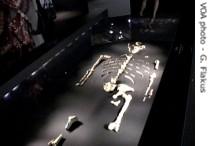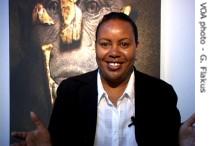2007年VOA标准英语-Hominid Fossil Lucy Visits the United States(在线收听)
Houston
28 August 2007
The fossilized bones of a female hominid creature found in Ethiopia in 1974 and today known around the world as Lucy are now in the United States on an unprecedented tour. The bones are part of a larger exhibit on Ethiopia, as both the birthplace of humankind and as a cradle of early civilization, that is set to open at Houston's Museum of Natural Science on Friday. But, as VOA's Greg Flakus reports from Houston, Lucy's tour outside Ethiopia has generated some controversy.

Lucy fossil display
The bones are arranged on a flat surface, protected by thick glass in a darkened room. Nearby, in another glass case, is a sculptor's rendition of what this female ancestor to humankind might have looked like when she walked the earth more than three million years ago.
 |
| Tadelech Dalacho |
Ethiopian officials say the payment from the museum in Houston will support their efforts to continue research and preservation of cultural artifacts back home. They are also using the Lucy exhibit as a way of promoting tourism to Ethiopia.
The partial skeleton, which was discovered in Ethiopia in 1974, was named by American paleontologists on the scene Lucy because they had been listening to the Beatles'song Lucy in the Sky with Diamonds at the time. Ethiopians, however, call her Dinkenesh, an Amarhic word for beautiful one.
 |
| Dirk Van Tuerenhout |
Houston Museum of Natural Science Curator of Anthropology Dirk Van Tuerenhout says the display of this fossil provides enormous educational benefits for the Houston community. He says this 40 percent complete fossilized skeleton provides the key to understanding human evolution.
"Even today, when other discoveries are made, no matter how old or how young, the benchmark continues to be 'how does your find relate to Miss Lucy, how does your find relate to Dinkenesh," he said.
Not everyone is happy that Lucy is on display here. Famed paleontologist Richard Leakey has condemned the removal of the fossil from its homeland as exploitation of an extremely important artifact. Other scientists have expressed concerns that the fossil might be damaged either in transit or during its planned six-year stay in the United States.
 |
| Joel Batrsch |
Houston Museum of Natural Science President Joel Bartsch says such fears are unfounded.
"When we first began conversations with our Ethiopian partners, we assembled a team of conservators to go down and study Lucy and make sure that she was, indeed, fit for travel. They reported back to us that she was literally hardy and robust. That is pretty high praise for a 3.2-million-year-old lady," he said.
 |
| Mamitu Yilma |
Yilma says she also relates to Lucy, or Dinkenesh, as more than just an assemblage of bone fragments on display.
"I have an emotional thing with her. I have trouble thinking of her as a fossil sometimes. I sometimes consider as a human being that has life in her," she said.
Museum officials in Houston say Lucy may make a side trip to the University of Texas in Austin for a CAT-scan procedure that would reveal more about the structure of the ancient bones, but that idea is still being negotiated with Ethiopian officials. Lucy is also expected to appear at some other U.S. museums over the next six years, but those deals are yet to be completed. What is certain is that Houston will be her home until April 20 of next year.